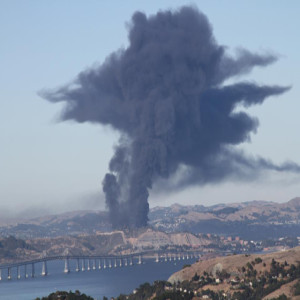
On this day in labor history, the year was 2012.
That was the day release of flammable vapor led to a fire at the Chevron refinery in Richmond, California.
A Level 3 Community Warning System Alert was issued for the cities of Richmond, San Pablo and North Richmond.
Toxic black smoke could be seen for miles while the fire burned for hours.
Nineteen workers were nearly incinerated trying to escape the fire.
More than 15,000 area residents sought medical treatment for chest pain, breathing problems, headaches and sore throats.
The Chemical Safety Board found that the release was caused by a leaking pipe that eventually ruptured.
The pipe, made of carbon steel, suffered sulfidic corrosion.
The CSB noted that for 40 years, the refinery industry had known that carbon steel corrodes at a much faster rate than higher chromium content steel pipe.
The pipe in question had no shut off valve to isolate the leak. In its final report, the CSB issued a number of findings.
They found that Chevron knew of the corrosion but did nothing to prevent it.
As well, Chevron not only failed to perform 100 percent component inspections, but also rejected earlier recommendations to inspect and replace the pipe that would eventually fail.
When it came to Emergency Response, Chevron failed to identify and communicate process controls or damage mechanisms in the incident command structure.
They also had no leak response guidance or formal protocol to determine how to handle a process leak.
The CSB found the Safety Culture lacking. Workers were reluctant to use their Stop Work Authority and were often encouraged to continue operations despite hazardous conditions.
The CSB issued a number of recommendations, including more stringent regulatory enforcement.
More Episodes
 2023-01-11
2023-01-11
 2023-01-10
2023-01-10
 2023-01-09
2023-01-09
 2023-01-08
2023-01-08
 2023-01-07
2023-01-07
 2023-01-06
2023-01-06
 2023-01-05
2023-01-05
 2023-01-04
2023-01-04
 2023-01-03
2023-01-03
 2023-01-02
2023-01-02
 2023-01-01
2023-01-01
 2022-12-30
2022-12-30
 2022-12-28
2022-12-28
 2022-12-27
2022-12-27
 2022-12-26
2022-12-26
 2022-12-25
2022-12-25
 2022-12-24
2022-12-24
Create your
podcast in
minutes
- Full-featured podcast site
- Unlimited storage and bandwidth
- Comprehensive podcast stats
- Distribute to Apple Podcasts, Spotify, and more
- Make money with your podcast
It is Free
- Privacy Policy
- Cookie Policy
- Terms of Use
- Consent Preferences
- Copyright © 2015-2024 Podbean.com




